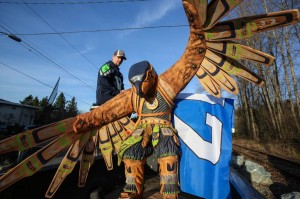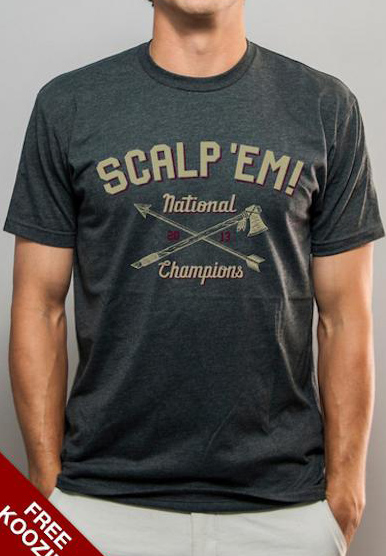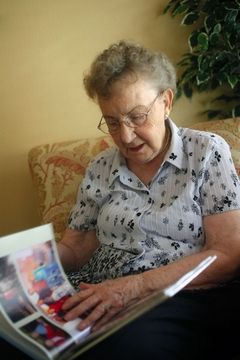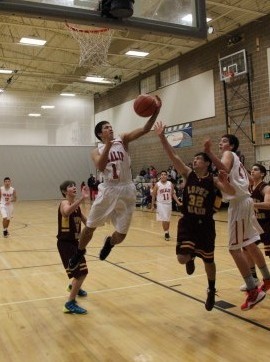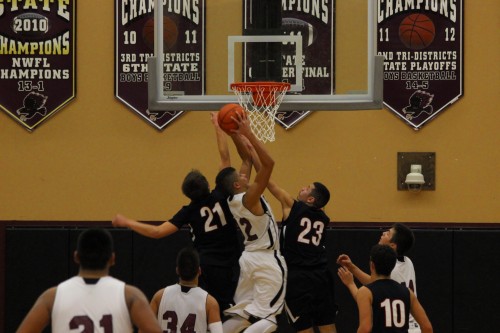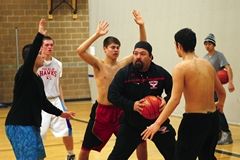
A group of Tulalip Heritage players guard assistant coach Cyrus Fryberg Jr. (center) during a drill at a recent practice. The Hawks are motivated to get to the state tournament in Spokane after falling just one game short last year.
The Hawks expect to get to state after falling short last season
By Aaron Lommers, The Herald
TULALIP — To understand the success the Tulalip Heritage boys basketball team is having this season, one first must understand the heartbreak that came before it.
Facing Taholah, a team Tulalip Heritage had beaten by 20 earlier in the season, the Hawks fell 57-45 in last year’s tri-district tournament. The Chitwhins advanced to state, while the Hawks season came to an abrupt end.
“It crushed them to lose that game, especially to a fellow tribal school,” Tulalip Heritage head coach Marlin Fryberg said.
The loss didn’t sit well with Fryberg either, who was forced to evaluate how it had happened.
“That changed the tone for me as the coach,” Fryberg said. “As head coach, I will take that (loss) as my responsibility. All summer long it weighed on them because they really wanted to go to Spokane and coming one game short I told them, ‘I own that. That’s my fault for not having you ready and I’ll never put you in that same situation ever again.'”
Of course Fryberg’s promise was two-sided. He has demanded more from his players at practice this season and redefined each player’s role on the team to eliminate any misunderstanding of their responsibilities.
Fryberg’s expectations of his players extend further than the basketball court. He expects them to maintain their grades in order to stay eligible and behave in the classroom.
“I think the success we’ve had is attributed to a lot of the dedication they have given to the discipline we’re demanding,” Fryberg said. “It gets down to the point where if they are tardy for school I’ll make them run. They’ll pay for it here because in life you’ve got to be disciplined.”
Grades have been a problem for Tulalip Heritage teams in the past, but not with this group. Fryberg said they’re all performing in the classroom — which has helped the Hawks perform on the court.
Fryberg’s squad has opened the season 12-1 and earned the No. 5 ranking in the state in the season’s first AP poll.
The only team to beat the Hawks this season is the team directly above them in the poll, No. 4 Lummi. The Blackhawks rallied from a 14-point halftime deficit to win the matchup of the then-unbeaten teams on Jan. 7. Lummi has since lost to Neah Bay, joining the Hawks, and every other 1B team in the state, with at least one loss.
Dating back to last season, the past three meetings with the Blackhawks have all been decided by three points or less.
“We’re right with them,” Fryberg said. “Mentally, we kind of fell apart a little bit and that’s what cost us the game.
The Hawks missed crucial free throws down the stretch that allowed Lummi to comeback and win a game that sophomore forward Robert Miles said they should have never lost.
“It really motivates us because we knew we should have had that game,” Miles said. “Even their crowd, they told us that they stole one from us and that we deserved to win it. That’s going to be a big motivator for us.”
The two teams renew their rivalry tonight, this time on the Hawks’ turf. With three meetings between the two schools in the regular season, Fryberg said the Hawks have to win to have a chance at a league championship.
“If we don’t win, they’re going to win the league,” Fryberg said. “It’s very important.”
“The first game is the important game,” Fryberg added. “That’ll tell you mentally as a ballplayer what you have to do. Or, if you’re on the losing side such as us, than we have to work harder. If you win that game, you’re kind of in the driver’s seat because you play three games. If you get one more out of the two, the way we’ve been running, you’re going to be first in the league.”
The game also brings large crowds many of the players aren’t used to playing in front of. Fryberg expects a similar sized crowd tonight.
“This is a rivalry between tribes that goes way back,” Fryberg said. “There are a lot of people. The (game) in Lummi was the biggest crowd ever up there in high school. And it went right down to the wire. It was great.”
The rivalry between the two schools is made stronger by the fact that many of the players play with each other or against each other in different tribal tournaments.
They’re all friends,” Fryberg said. It makes it a bigger rivalry when they come together.”
Senior Keanu Hamilton, one of the Hawks’ leading scorers, said the team will have to work even harder if it expects to avenge the earlier loss to the Blackhawks.
“If we worked that hard (before the first Lummi game), than we’ve got to work harder,” Hamilton said. “It’s going to be a big game. They’re our rivals and they’re coming here. We almost had them there. It’s going to be huge here.”
Tonight’s game is just another step toward the Hawks ultimate goal of competing for the state championship at Spokane Arena in early March. The Hawks’ consistent effort the first 13 games of the season has put them in a position where that goal seems attainable.
Fryberg has been involved with basketball for the better part of his life, but advancing to the state tournament is something that eluded him as a player.
Hamilton doesn’t want to have that same regret.
“Coach is always talking about how he can never raise his hand and say that he’s been there,” he said. “I want to raise my hand and say that I’ve been there.”


